Skywatcher AZ EQ6-GT Review Part-11 Comment9 April 2013 | Steve The new Skywatcher AZ EQ6-GT has had a successful launch and has been well received. Customer feedback so far is excellent and we have experienced zero returns but there is still very little in the way of in-depth reviews on the internet. To remedy this we sent one to Steve Richards for a long-term review :-) Steve Richards is the author of ‘Making Every Photon Count’ and writes for The Sunday Times, BBC Sky at Night Magazine and BBC Focus Magazine. Here is part-1 of his Skywatcher AZ EQ6-GT review: IntroductionThe Sky-Watcher (N)EQ6 has always been a popular mount for imagers and observers alike, especially those with heavyweight equipment. However, not all observers want or need the added complexity of an equatorial mount and an altazimuth mount will do just nicely. The new Sky-Watcher AZ-EQ6 GT mount gives you a a choice in how you use it as it can be assembled and operated in either equatorial of altazimuth mode. In altazimuth mode you can even mount two telescopes at the same time using the standard hardware that is supplied with the comprehensive kit. The AZ-EQ6 GT is clearly an evolution of the NEQ6 but one in which the manufacturer has apparently listened to its customers because, as well as its dual functionality, it has several new features that provide worthwhile enhancements over the earlier design. I have the AZ-EQ6 GT on loan for a long-term review so this article is a preliminary look at the new mount that will be added to in the light of operational experience over the next few months.
Specification of the review sample
What's in the box?
DescriptionFinished in Sky-Watcher’s normal white finish and trimmed with brushed aluminium components, the AZ-EQ6 GT is a very attractive and solid looking mount with more rounded lines than its predecessor which gives it a more ‘finished’ appearance. Surprisingly, the mount achieves this whilst shedding 0.8kg in weight which is sufficient to make a worthwhile difference when it comes to portability as it feels a lot lighter. The mount ships with its own heavy duty tripod which is identical to that of the original NEQ6 so the mount will fit directly on to observatory piers designed for the earlier mount which is good news for people upgrading from the NEQ6. The mount sports a 25mm diameter stainless steel counterbalance bar which is 207mm long but can be increased in length by a further 150mm using the supplied extension bar. This retractable bar is not only substantially fabricated but its locking mechanism makes its connection in the DEC axis very rigid indeed. A heavy-duty 12mm threaded toe protector ensures that the two 5kg counterweights cannot slide off the bar accidentally. In equatorial mode, the two weights and extension bar were just sufficient to balance a fairly weighty Sky-Watcher 250PX Newtonian Reflector with a relatively heavy Baader Hyperion eyepiece installed in the focuser.
The Azimuth adjustment method is unchanged, using two opposing hand bolts with 34mm diameter plastic knobs working against a central post.
In addition, there is also a software-assisted Polar Alignment routine requiring the alignment of at least two test stars (but preferably three to obviate cone errors) followed by the selection of a further test star. This last star is selected after choosing ‘Polar Re- Align’ from the handcontroller’s menu options and then centring it in the eyepiece. Once centred using the direction keys, the routine moves the telescope to an offset position and you then re-centre it manually using the altitude and azimuth adjustment bolts. This process uses a complex algorithm to correct any polar misalignment detected in the star’s position. Gone too are the single arm clutch knobs for the RA and DEC axes. A very elegant three pronged capstan-shaped clutch locking mechanism works flawlessly on the DEC axis and unlike its predecessor, this doesn’t shift the axis as it tightens. The RA clutch is a single pronged chrome finished capstan at the base of the RA axis surrounding the polarscope. Both clutches are a joy to use, especially with cold hands in the dark!
RA Clutch DEC ClutchExisting users of Sky-Watcher mounts will be quite at home with the SynScan handcontroller which was updated to firmware version 3.32 using the RS232 cable supplied with the kit. Various catalogues totalling in excess of 42,000 objects including Messier, NGC, IC, SAO, Caldwell, Double Star, Variable Star, Named Star and Solar System are available. However, the real bonus is that this mount maintains compatibility with the very popular and free ASCOM software, EQmod giving access to many more objects and offering comprehensive computer control using your planetarium software. Hitech Astro supplies a convenient USB adapter to implement the EQMod connection between the PC and mount. The AZ-EQ6 GT continues to use stepper motors for its drive but these are augmented with 6,356 tic/revolution encoders on both axes which are used for improving GoTo accuracy but play no part in controlling the accuracy of sidereal tracking. These encoders remain functional with the clutches disengaged but the mount turned on so you can manually push the telescope about to another part of the sky should you wish to do so and the encoders will keep the system updated with where the mount is currently pointing.
A common problem with many mounts including the NEQ6 is the relatively poor power connection that relies on a standard DC type plug. This type of plug is fine for static equipment but less so when the socket is part of a moving device as is the case with a typical Sky-Watcher mount. Sky-Watcher have provided a two prong plug and socket system on the new mount that incorporates a locking collar which is a huge improvement on the original and ensures that accidental disconnection cannot happen. Included on the faceplate that contains the power connection socket, you’ll find an 8 pin RJ45 handcontroller socket, a 6 pin RJ12 ST4 guide port, On/Off power switch, a red LED and a small 3.5mm stereo socket labelled ‘Snap’. The Snap socket allows the SynScan handcontroller to initiate a sequence of up to 8 sets of exposures (with each set comprising exposure time and number of exposures) using an attached DSLR camera. A cable suitable for the Canon EOS range of DSLR cameras is included but cables for other camera makes can be ordered or you can make up your own lead using the wiring information included in the manual. When the mount is used in altazimuth mode, the altitude adjustment bolt is adjusted towards the 90° point where it disengages from the mount’s base swivel at about 88° elevation. The mount is then locked in place at 90° elevation using a 12mm diameter bolt, which in equatorial mode is retained in a threaded receptacle on the side of the mount. With the ‘RA’ axis now vertical, this becomes the azimuth axis and the ‘DEC’ axis becomes the altitude axis. A single telescope can be mounted in the standard dual-size saddle clamp and counterbalanced with a suitable weight on the counterbalance bar. However, Sky-Watcher supply a second dual-size saddle clamp that affixes to the counterbalance bar and tightens securely onto a machined flat on the end of the counterbalance bar allowing two telescopes to be installed at the same time. The two telescopes balance one another by adjustment of the amount of counterbalance bar extension you provide. The second saddle clamp has a very neat altitude adjustment to allow you to point both telescopes at the same elevation although there is no matching adjustment for azimuth. |
|
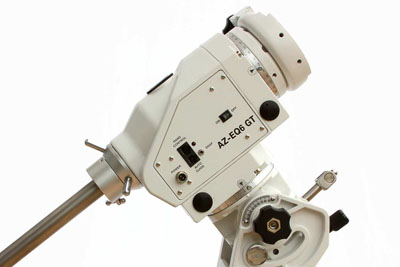
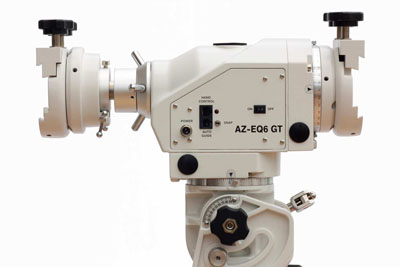
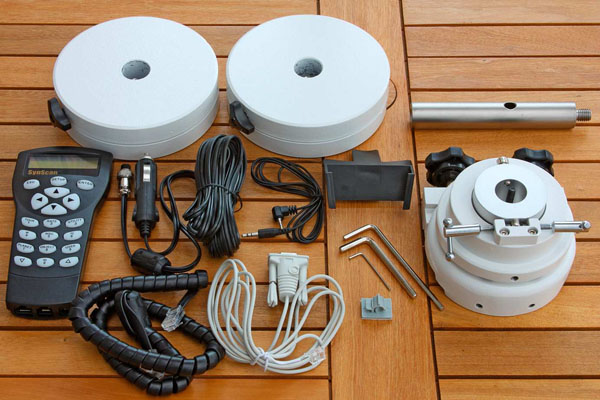 The mount arrived in two sturdy cardboard boxes The first contained the mount with dual Losmandy/Vixen saddle clamp, SynScan handcontroller, holder for the handcontroller, power and data cables, a camera control cable, a 150mm counterbalance extension bar, a robust looking second saddle clamp assembly and some Allen Keys.
The mount arrived in two sturdy cardboard boxes The first contained the mount with dual Losmandy/Vixen saddle clamp, SynScan handcontroller, holder for the handcontroller, power and data cables, a camera control cable, a 150mm counterbalance extension bar, a robust looking second saddle clamp assembly and some Allen Keys.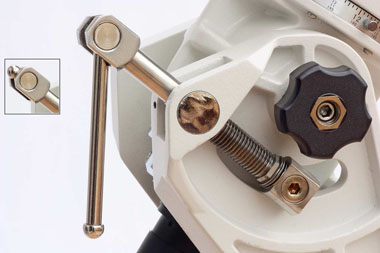 Gone are the sometimes troublesome opposing altitude bolts. These are replaced with a very smoothly operating 16mm diameter hand bolt that works against two swivel blocks, one on the mount base and one on the mount head itself, to produce a very elegant solution to altitude adjustment that is simple to operate one- handed. The hinged Tommy bar on the end of the altitude adjustment bolt stows neatly away inside the bolt head when it has done its work and once the correct altitude has been selected, two substantial plastic knobs lock the mount head solidly in place. The ease of adjustment using this new system cannot be overstated!
Gone are the sometimes troublesome opposing altitude bolts. These are replaced with a very smoothly operating 16mm diameter hand bolt that works against two swivel blocks, one on the mount base and one on the mount head itself, to produce a very elegant solution to altitude adjustment that is simple to operate one- handed. The hinged Tommy bar on the end of the altitude adjustment bolt stows neatly away inside the bolt head when it has done its work and once the correct altitude has been selected, two substantial plastic knobs lock the mount head solidly in place. The ease of adjustment using this new system cannot be overstated!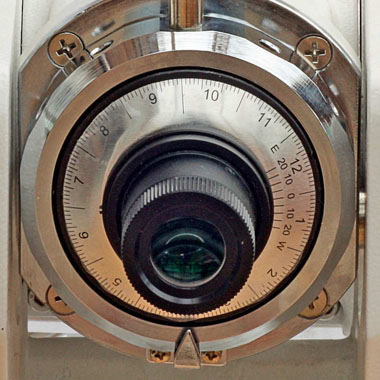 A standard Sky-Watcher illuminated Polarscope with etchings for the Polaris circle, The Great Dipper and Cassiopeia for use in the northern hemisphere and Octans for the southern hemisphere is supplied already installed in the base of the RA axis.
A standard Sky-Watcher illuminated Polarscope with etchings for the Polaris circle, The Great Dipper and Cassiopeia for use in the northern hemisphere and Octans for the southern hemisphere is supplied already installed in the base of the RA axis.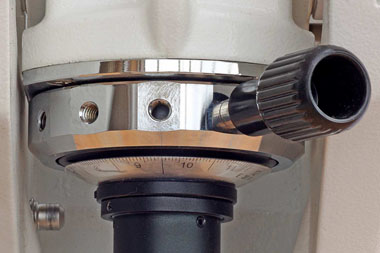
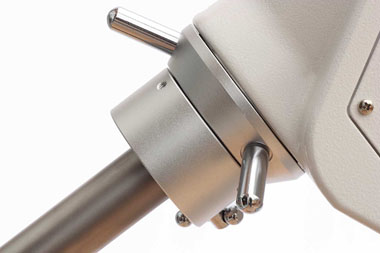
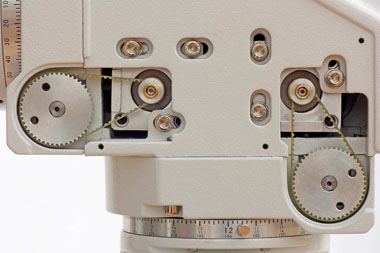 The mount is even quieter than the NEQ6 which was always excellent in this regard. This relative quietness is no doubt helped by the hybrid drive system that uses a 48:12 reduction toothed belt drive from each stepper motor to the worm gear followed by a 180:1 worm gear reduction resulting in a total gear ratio of 720:1. This new drive system is very smooth and accurate in operation.
The mount is even quieter than the NEQ6 which was always excellent in this regard. This relative quietness is no doubt helped by the hybrid drive system that uses a 48:12 reduction toothed belt drive from each stepper motor to the worm gear followed by a 180:1 worm gear reduction resulting in a total gear ratio of 720:1. This new drive system is very smooth and accurate in operation.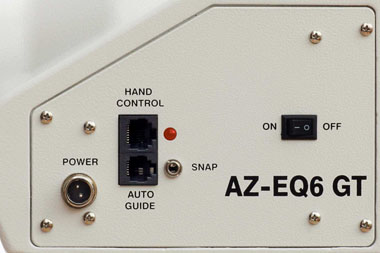
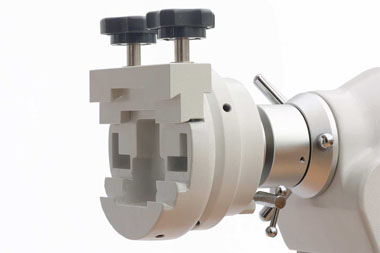






At last some serious details on this mount. Answers most of the questions I asked in my email. Still like to know if my eq3 external GPS module will work on this mount.